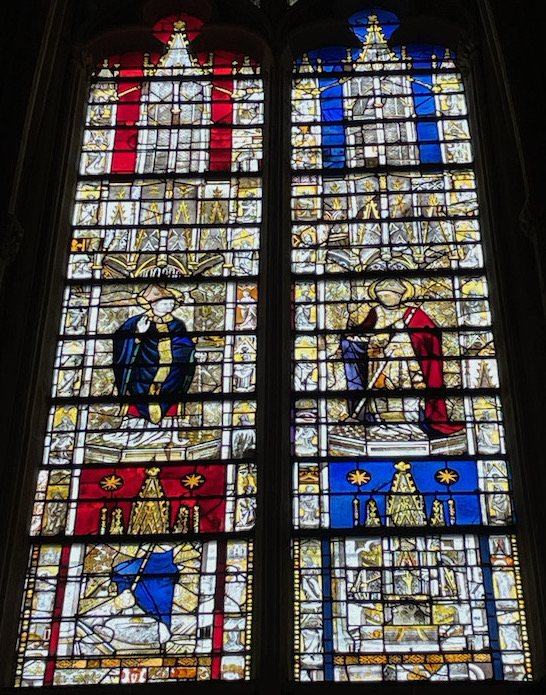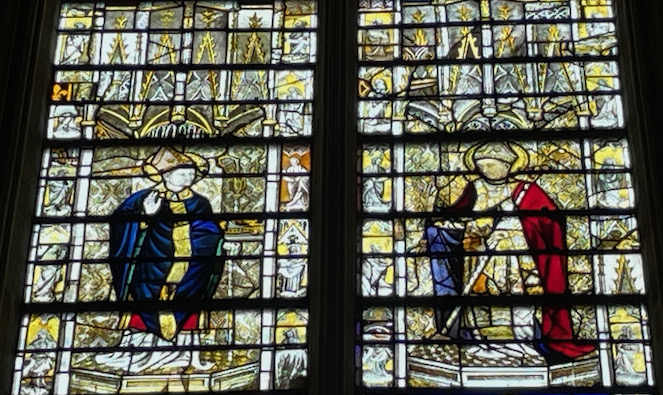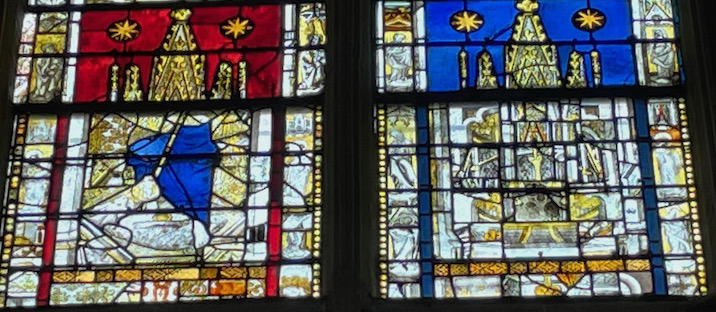Our Blog - Stained-glass windows at Cathedral Saint-Etienne, Toulouse, France
For the Journées de Patrimoine this year, the Cathedral Saint-Etienne had additional information available on the majority of the stained-glass windows. As most of you can tell who have read my blog for awhile, I am a huge fan of stained-glass windows, so we had to go stop by. This blog is ONLY about the stained-glass windows so if you don't like them, you may not want to go through this one :-)
The "Grand Rose Window" is modeled off of the Western rose window of Notre Dame Cathedral in Paris. It was installed in the 15th century. The window celebrates the triumph of the Church. God is shown in the middle, wearing a crown and seated on a golden throne. Around him are saints, angels, kings, bishops, and a few donors.
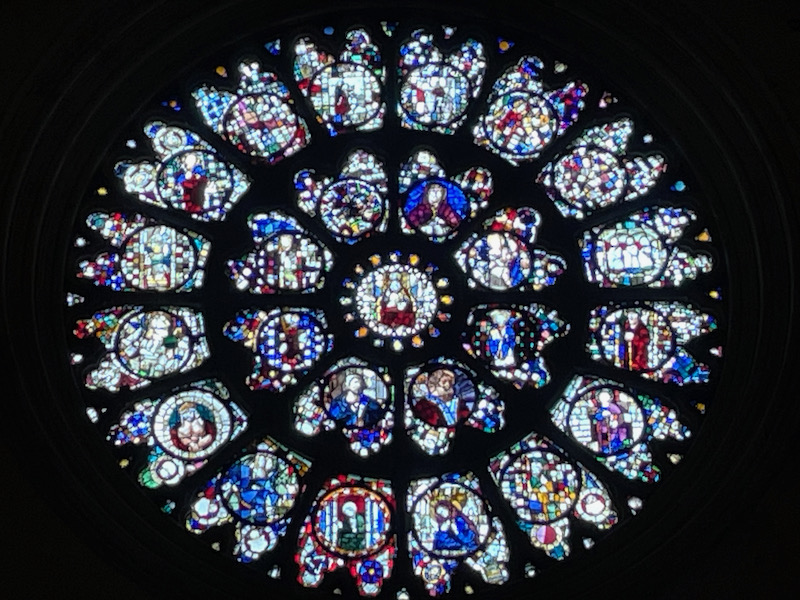
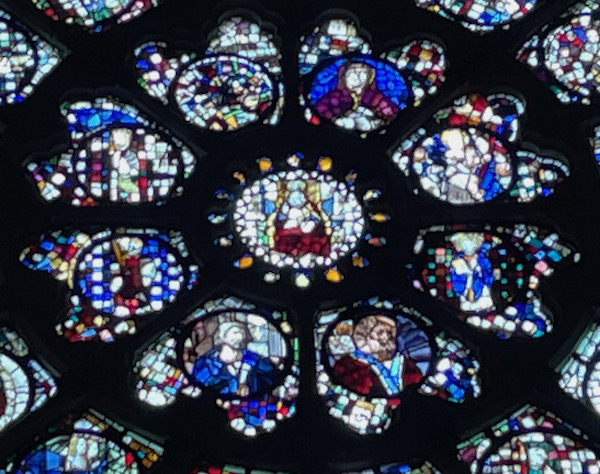
This next window depicts prominent people of the Cathedral. This is one of the newer windows, created in 1952 by a stained-glass artist who created 12 windows for Notre Dame Cathedral in Paris (and all of his windows were spared during the 2019 fire there). At the top is Saint Etienne, and then along the left side (top to bottom) are Saint Saturnin, Izarn, Bertrand of l'Isle, and the Provost Jean Daffis. Right side (top to bottom) are Saint Exupère, Raymond VI, Jean d'Orleans, and JG Saliege.
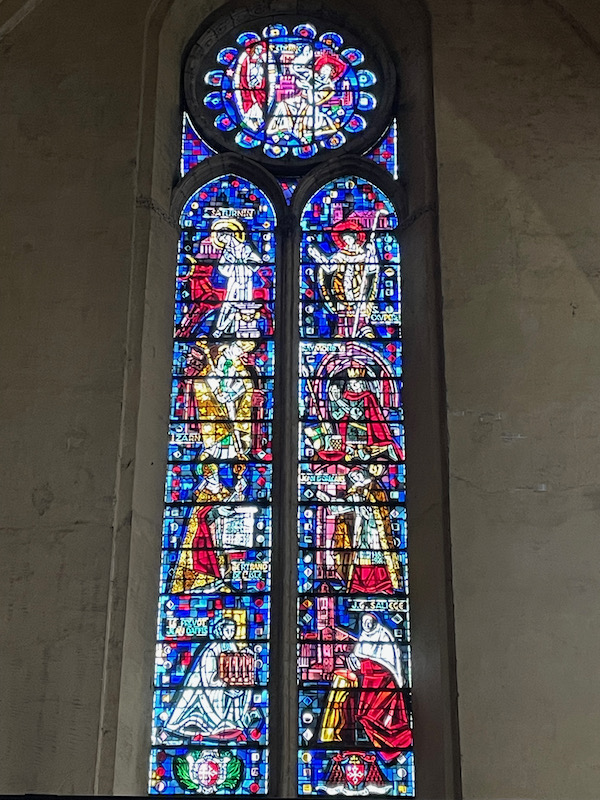
You will be able to see how these are pretty modern compared to others you will see, but they still fit in well with the other windows. I tried to get some close-up pictures (I'm so looking forward to a better iPhone camera soon!) Here we have Saint Etienne, who is the patron saint of the cathedral, in the top panel. He is shown twice: On the left side, he is draped in red. On the right, he seems to be down on one knee, protecting himself from stones, some of which are visible on the ground.
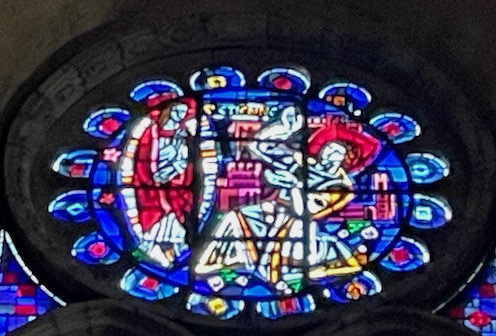
Moving down, on the left side is Saint Saturnin (sometimes spelled Saint Sernin) who was the first Bishop of Toulouse and built a chapel here in the 3rd century, shown with a red bull. This is a well-known story with this Saint and his martyrdom in Toulouse in Roman times, where he was tied to a bull and dragged through town. Saint Exupère was the Bishop of Toulouse from 402-411, who rebuilt the chapel 150 years later.
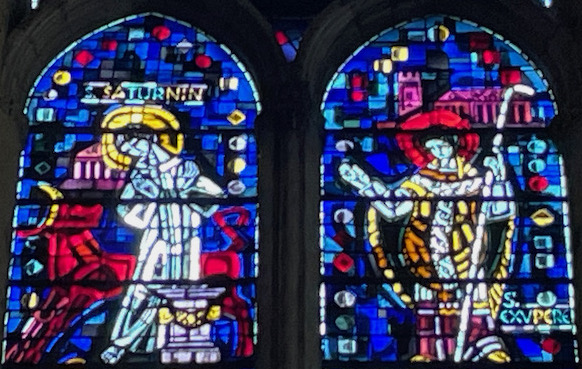
Down another set, we have Izarn, who was the Bishop of Toulouse from 1070 to 1105, who launched the construction of a Romanesque church with 3 naves on the ruins of the chapel. Next to Izarn is Raymond VI, the Count of Toulouse from 1194-1222. The nave here is sometimes called the "Raymondine nave" because it was attributed to the Count of Toulouse Raymond VI. He is shown on his knees praying, with a crown on his head.
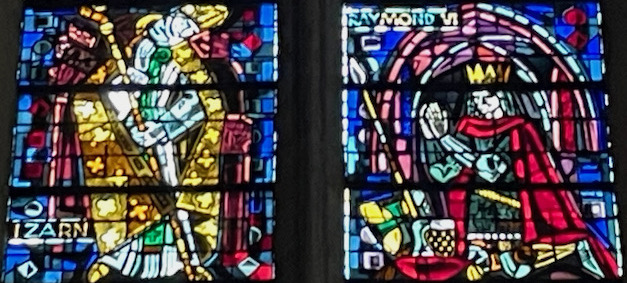
Then we have Bishop Bertrand de l'Isle, who in 1270, decided to transform the church into a large Gothic cathedral. Jean d'Orleans, the Archbishop of Toulouse in the 16th century, continued the work, adding the transept, several chapels, and the brick bell tower.
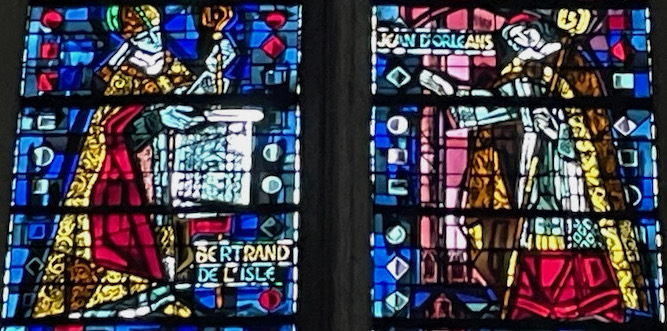
At the bottom, we have Provost Jean Daffis, who was instrumental in the restoration of the cathedral after a fire in 1609 devastated the vault and choir. Cardinal Jules Géraud Seliège was Archbishop of Toulouse and is known for denouncing the deportation of Jews and Nazi atrocities during the occupation of France in WWII. You can make out the Cathedral, with its bell tower, in the upper-left corner of the pane.
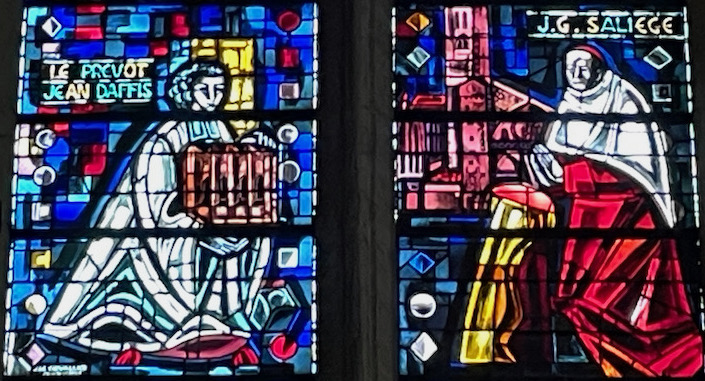
Three more modern windows, these were installed in March 1962. The first one shows 2 Bishops of Toulouse: Saint Sylve (left) and Saint Germier (right). Saint Sylve was the 4th Bishop of Toulouse from 360 to 400. Saint Sylve started the construction of a paleo-Christian church outside the city which would become the Basilica Saint-Sernin in the 11th century. Saint Germier was another Bishop of Toulouse, at the beginning of the 6th century.
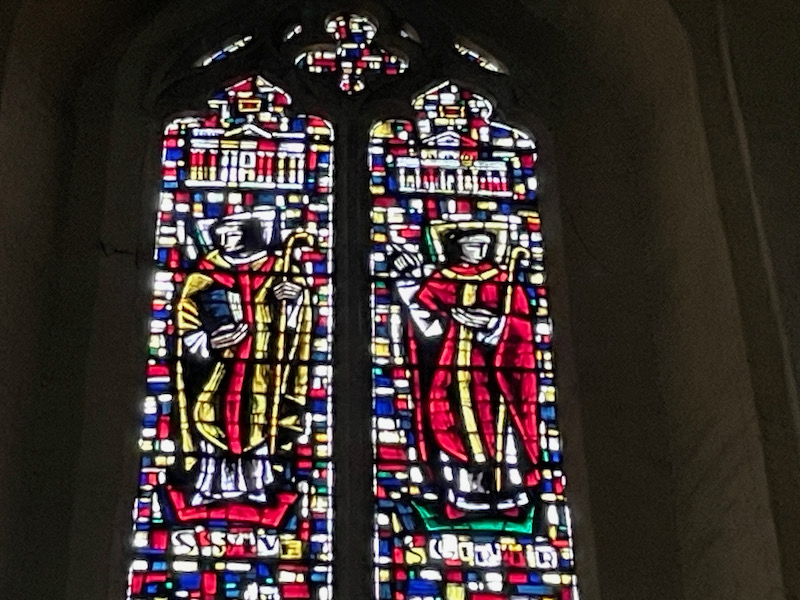
The stained-glass window of Saint Dominic has Saint Dominic in the center with Saint Thomas Aquinas and Saint Vincent Ferrier on the left-and-right, respectively. Saint Dominic Guzman was born in Spain around 1170 and was the founder of the Order of the Dominicans in Toulouse in 1215. Saint Thomas Aquinas was an Italian theologian who traveled throughout Europe. While he never actually visited Toulouse, his relics were given to the Dominicans in 1368 by Pope Urban V, and the reliquary sits under an altar at the former Convent of the Jacobins in Toulouse. Saint Vincent Ferrier was a French priest in the Order of the Dominicans.
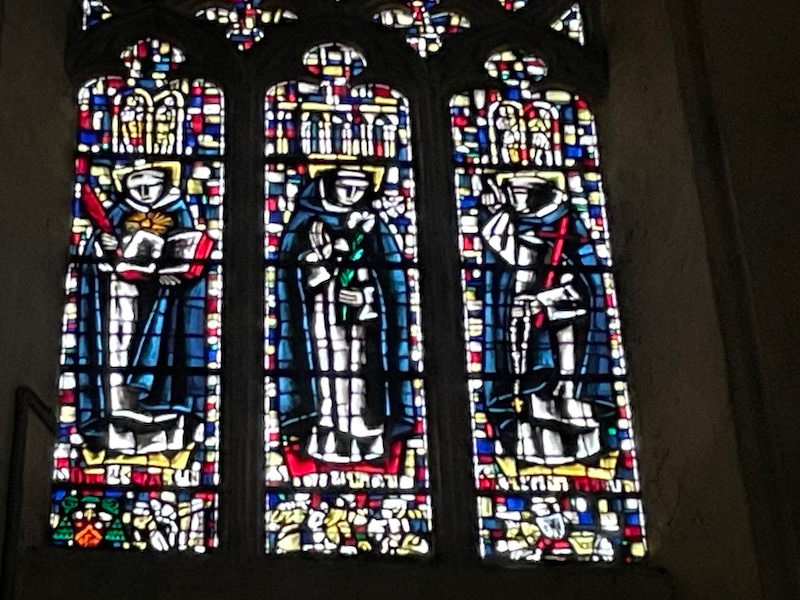
The last of these depicts the foundation of the University of Toulouse. You can see how the color red dominates in this window, compared to the blue color in the window just above. The 3 figures across the middle are Saint Louis on the left, Pope Gregory IX in the center, and the Raymond VII, Count of Toulouse on the right. The University of Toulouse was the first university created in France in 1229. Pope Gregory IX granted universal validity to the teaching licenses that were issued by the university.
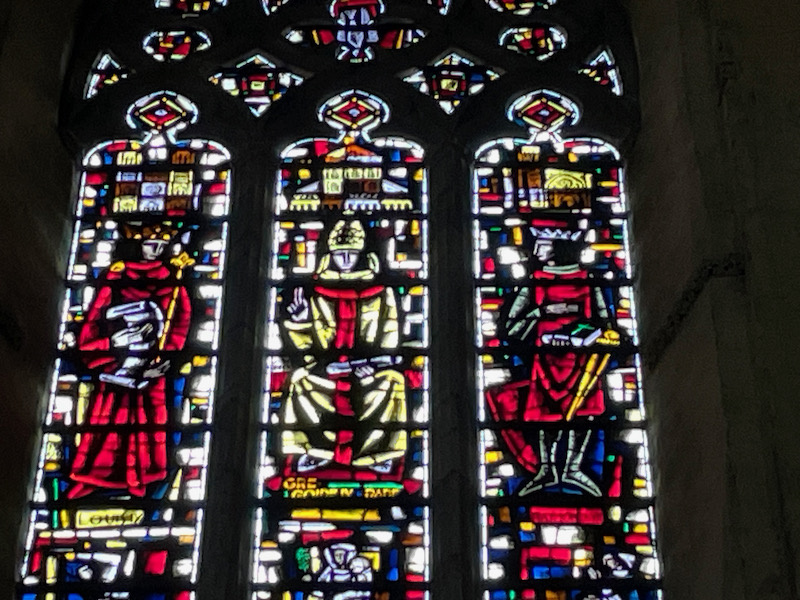
Now we move to the choir and the set of high stained-glass windows there. All of these windows date from between 1612 and 1613 and were done after a fire in 1609. Prior to the fire, the roof of the choir was not vaulted. But the roof was destroyed in the fire and the architect decided to put in a vaulted roof which allowed for these new windows.
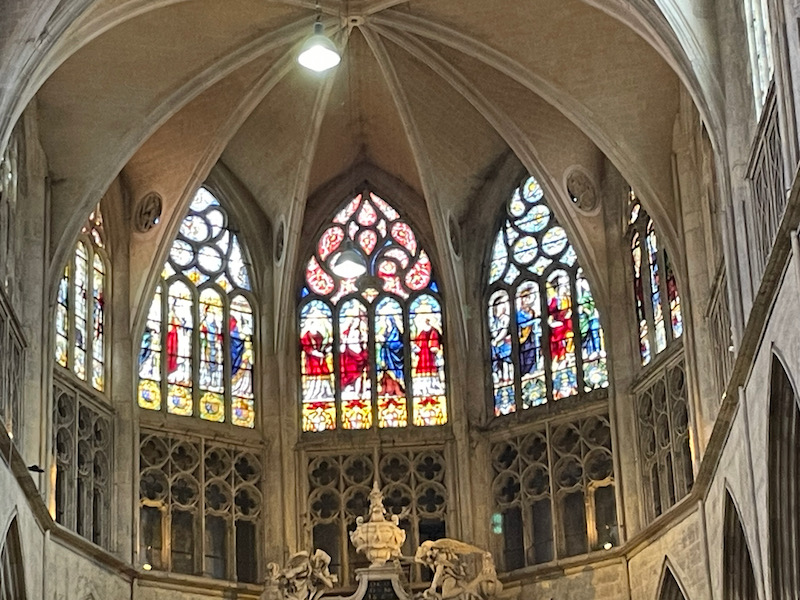
In the center window, we see Christ and Mary in the middle, with Saint Etienne (Saint Stephen in English) on the left and Saint Laurent (Saint Lawrence in English) on the right. Saint Etienne was the first martyr of Christianity. The two saints on the right-and-left carry green palms, symbolic of martyrs, and are dressed in red tunics, symbolic of deacons. The other windows show various apostles and bishops. (sorry about the odd angles of the pictures).
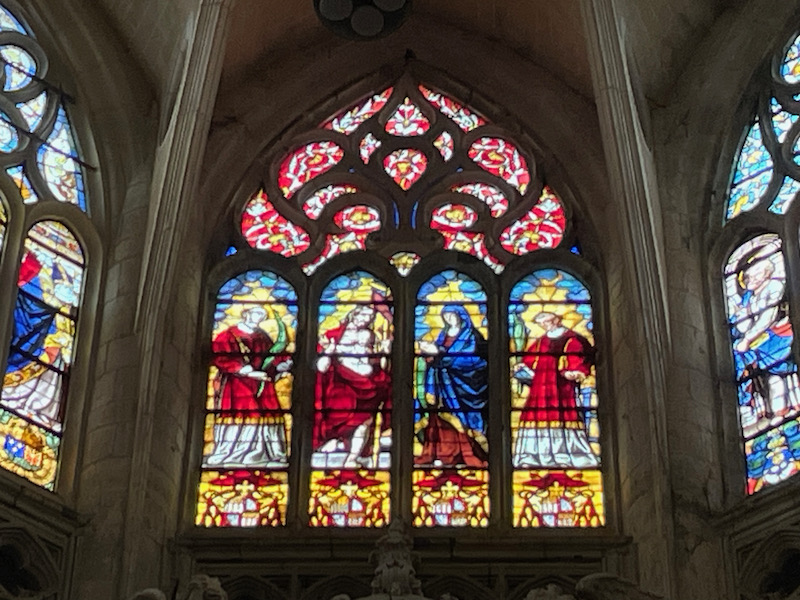
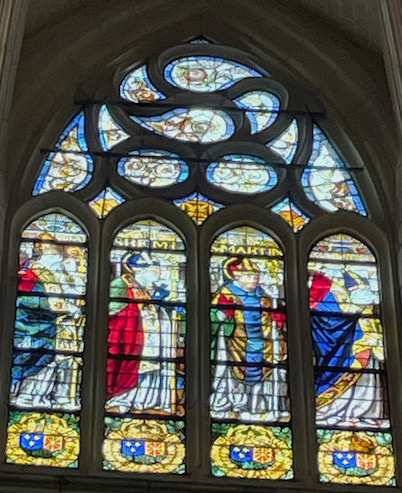
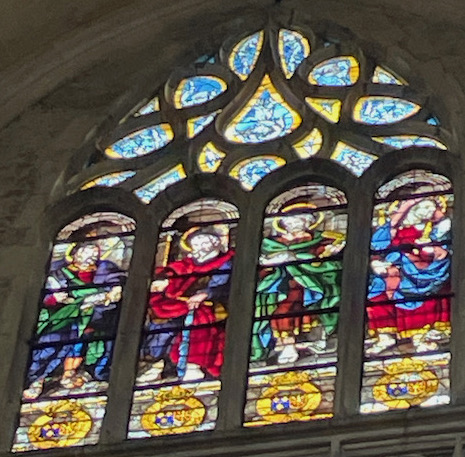
The Gothic nave is surrounded by 15 pentagonal chapels, vaulted in the last years of the 13th century. Most of the chapels have at least 1 stained-glass window. The first chapel is that of Saint François Xavier and the windows date from the 15th and 19th centuries. The top 2 panes show Saint Jacques (left) and Saint John the Baptist (right). Below them is a virgin slaying a dragon (left) and Saint Etienne/Saint Stephen (right). Saint Etienne/Saint Stephen is shown with stones near his head and at his feet, depicting that he was stoned to death.
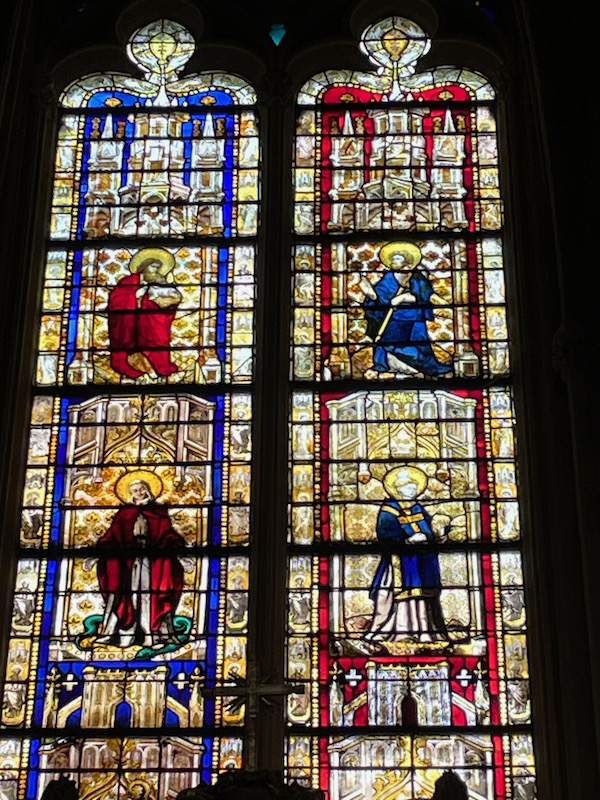
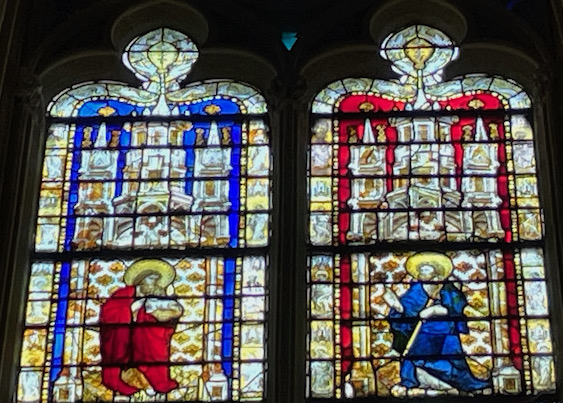
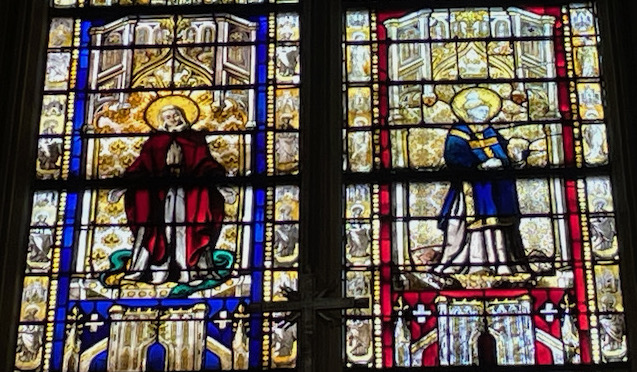
The windows in the chapel of Jeanne d'Arc have nothing to do with Joan of Arc :-) They date from the first half of the 16th century, and so you can tell a distinct difference between this window and the ones you just saw. The top panes show the descent from the cross with Joseph of Arimathea, in a gold damask cloak, looking on, and then the body being held by Mary with Saint John and a holy woman. Below that are 2 scenes: Saint Roch depicted as a pilgrim with his dog (he is the patron saint of dogs) and then Saint Sebastian being pierced by arrows with an angel above him presenting him with the crown of martyrdom.
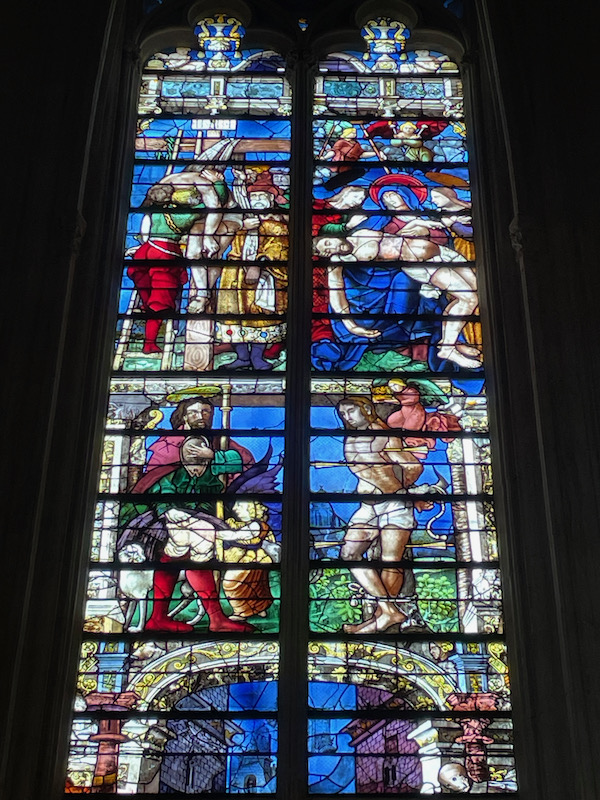
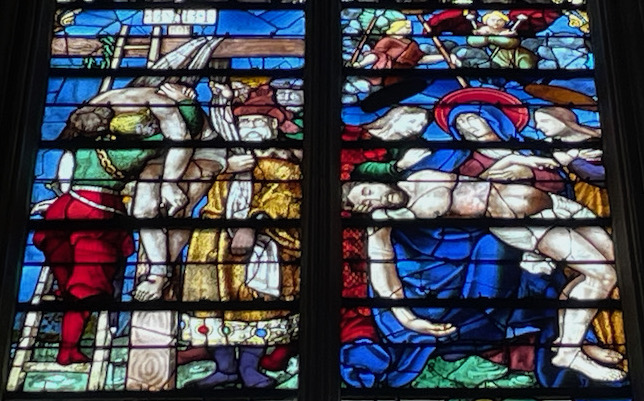
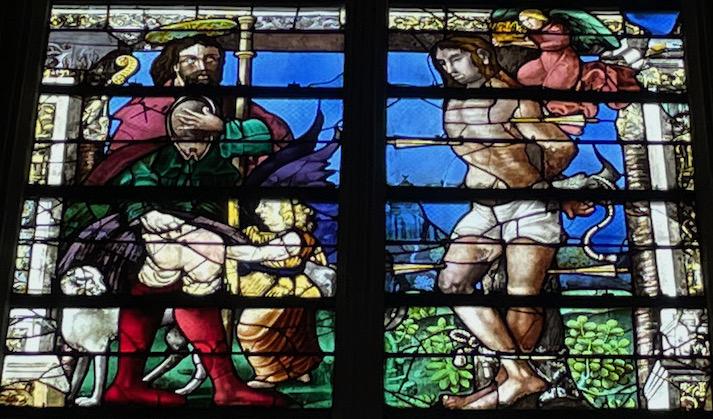
The Chapel of Saint John the Baptist has two stained-glass windows from different time periods and very different styles. The first window dates from the 14th century and the dominant colors are blue and red. The second window, with various bishops, dates from the 19th century and the dominant color is brown.
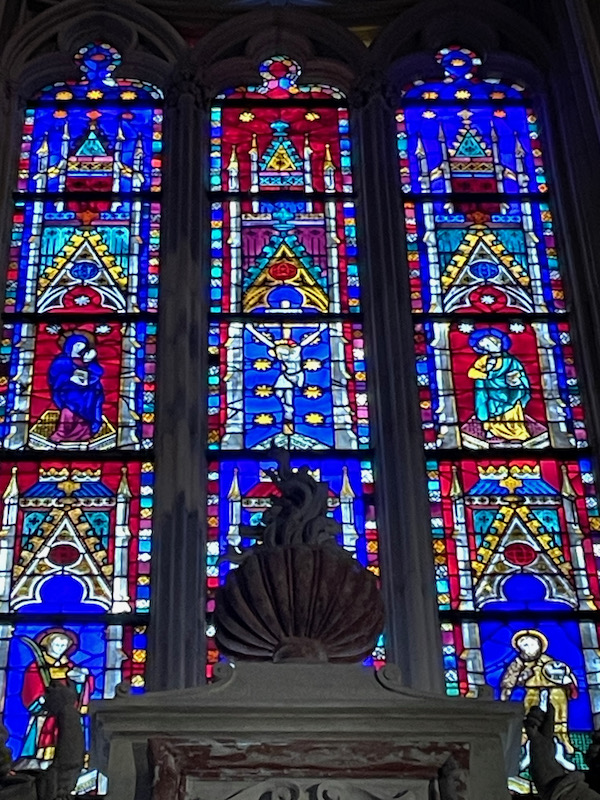
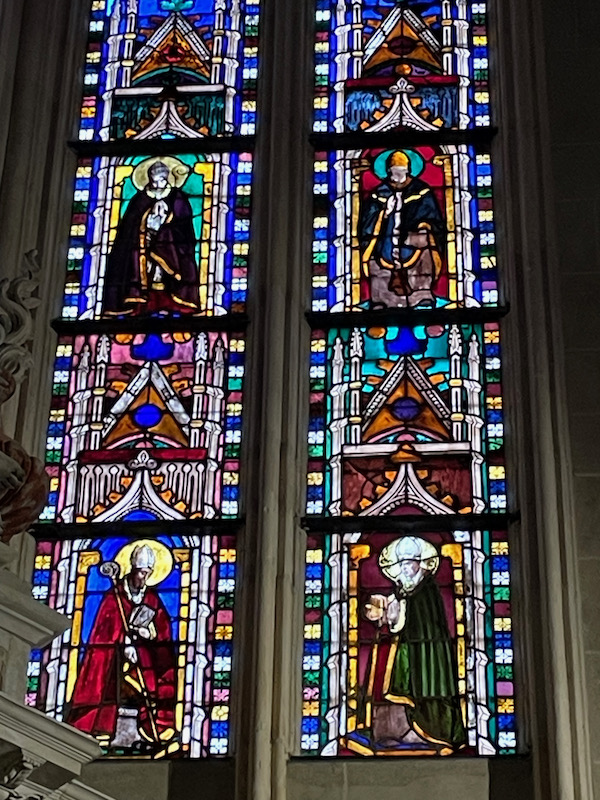
At the back of the choir is the Chapel of the Sacred Heart. These windows date from the 19th century and were installed after some work in 1850. There are 14 figures shown under triangular-shaped canopies, including Christ and Mary in the first window in the 2 middle panes (this is the middle of the 3 windows). The 2nd and 3rd windows have the same style, with figures under triangular-shaped canopies. But with these two, there are only 2 lancets of glass and the outer lancet is actually a painted tromp-l'œil following the same style.
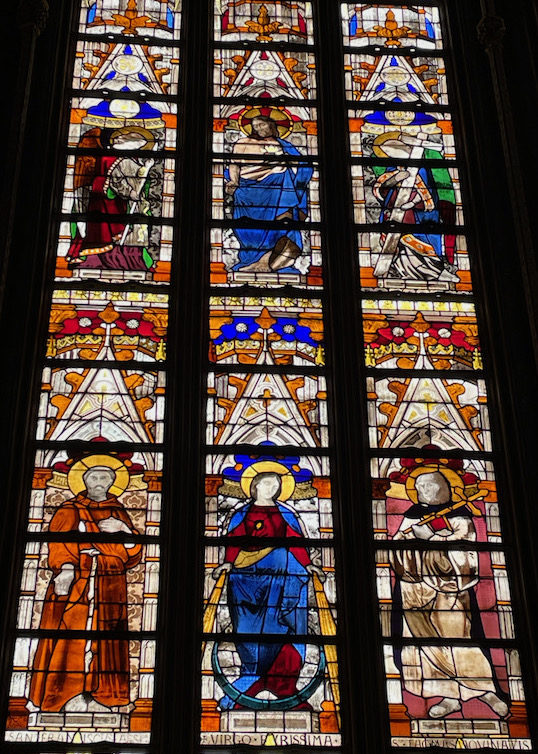

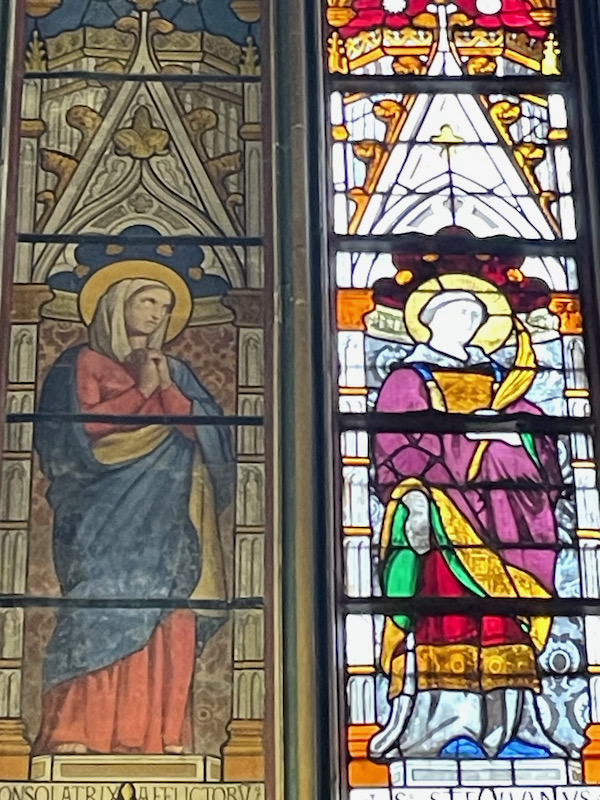
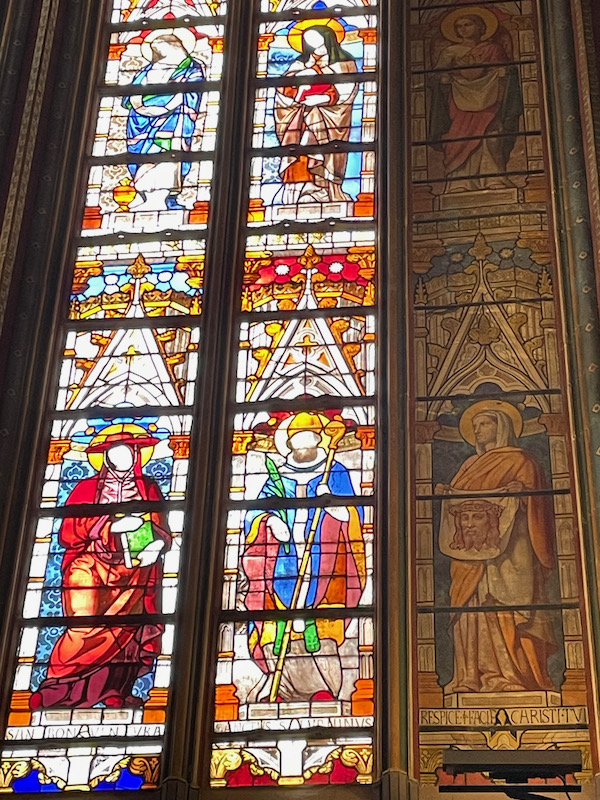
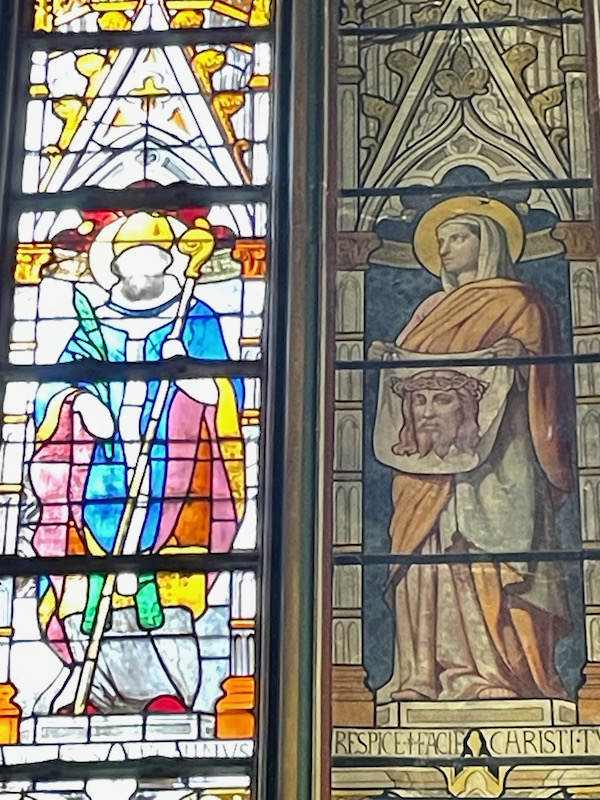
The window in the Saint Joseph Chapel is the most famous stained-glass window in the Cathedral, known as the "royal window". It was completed in 1470. The left window shows the Archbishop Denis du Moulin, dressed in red with the mitre (hat) of a bishop, "presenting" King Charles VIII, the King of France from 1422 to his death in 1461, dressed in a cape with the royal French fleur-de-lis. The iconography here is an interesting mix of religion and politics, since he is shown in prayer and haloed like a saint. The central window shows Saint John the Baptist on the left and Saint Catherine of Alexandria on the right. And then the right-hand window shows the dauphin Louis, future King Louis XI, kneeling and dressed as a knight being "presented" by Louis of Anjou, the bishop of Toulouse (with the mitre). An interesting story here ... Louis of Anjou was made the Bishop of Toulouse in February 1297 at the age of 22 and rapidly gained a reputation for serving the poor, feeding the hungry, and ignoring his own needs. After just 6 months, apparently exhausted by his labors, he abandoned the position of bishop and then died a month later. He was was canonized in 1307 as Saint Louis of Toulouse. I found it funny that, while the window was done in 1470, he is still shown as a Bishop instead of a Saint.
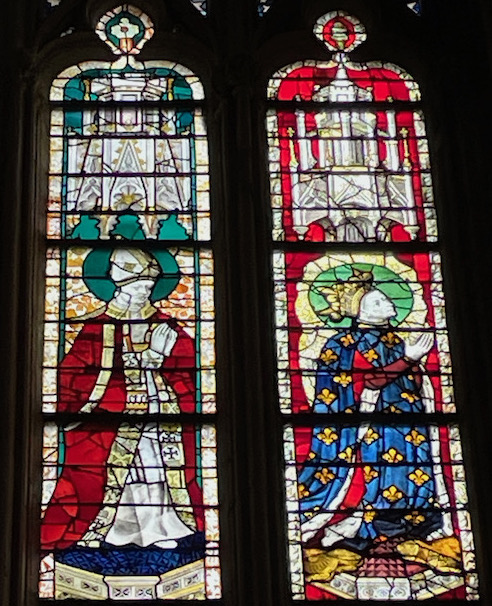
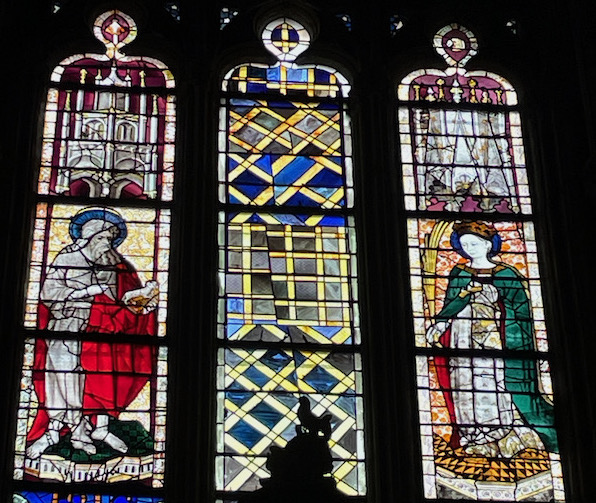
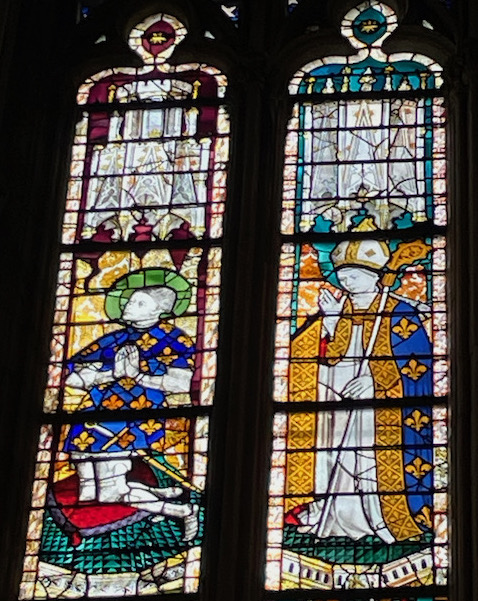
The window in the Chapel of Relics is a bit difficult to see but you can clearly see the Saint Stephanus in the middle with Saint Vincent and Saint Lawrence on either side. Saint Stephanus wears a red cloak and carries a gold palm in one hand (indicating a martyr) and holding a box containing the Eucharist in the other. The bottom row are hard to see because it had things in front of the window. The window is dated to the middle of the 14th-15th century due to the abundance of a technique called "silver yellow". This is a color family which is obtained by metallic salts that penetrate the glass during firing. This produces a color that can range from very light yellow to dark orange-brown. This "silver yellow" revolutionized the technique of stained glass windows because it was now possible to add a yellow color to the same piece of glass as another color without separating it with lead.
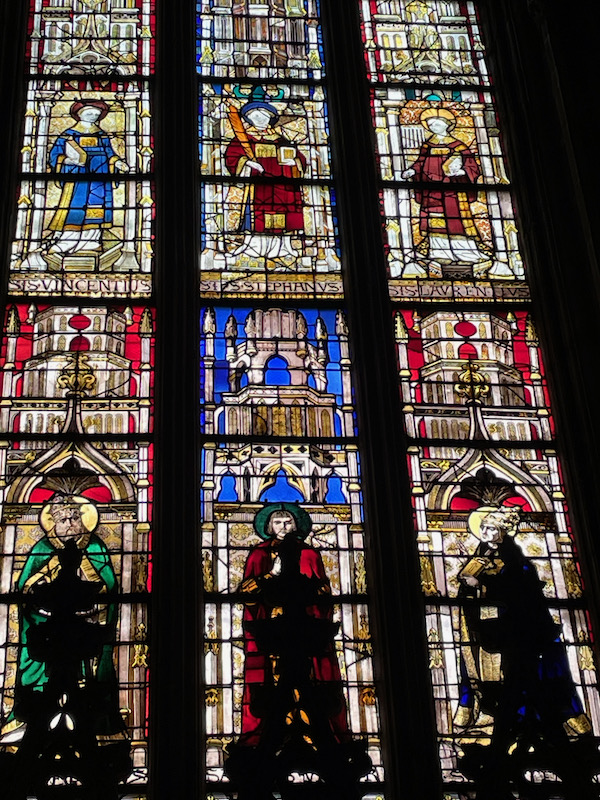
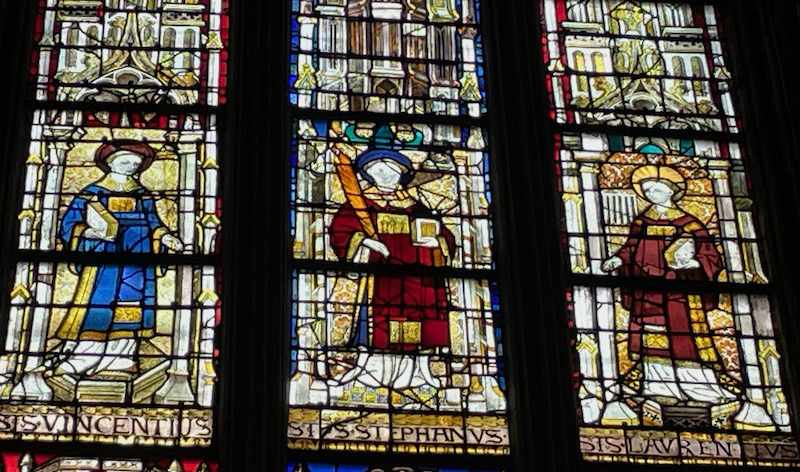
A 19th-century window in the Chapel of Sainte Croix, this one dating from 1879. Again, you can see a difference in style between this window and the one we saw just above. On the upper section, you can see Saint Louis (in blue) bringing back the crown of thorns that he carries on a red velvet cushion. The lower section shows the Emperor Constantine brining back the "true cross". The officers escorting the Emperor are dressed based on the military at the Palais Niel in Toulouse, and the Archbishop looks like Cardinal Despresz, the Archbishop of Toulouse from 1859 to 1895. You can also see a couple coats-of-arms at the bottom ... these represent the donors who paid for the window.
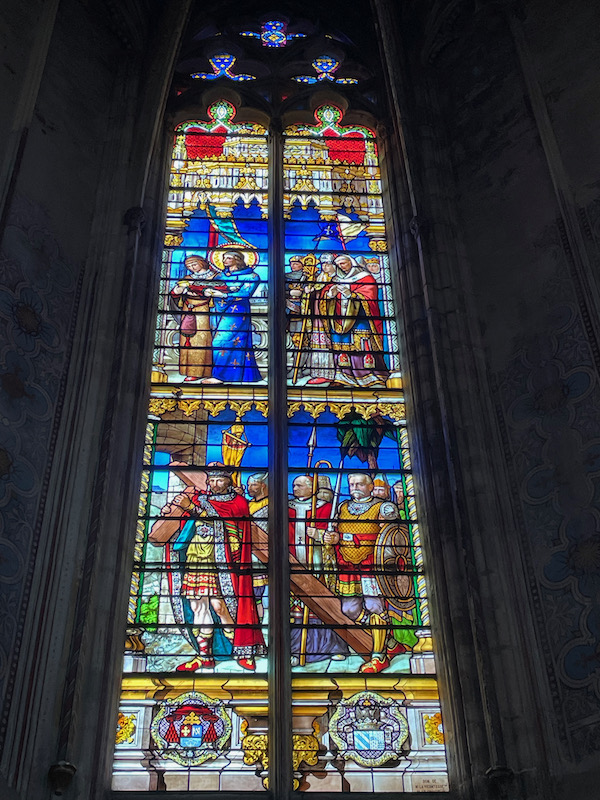
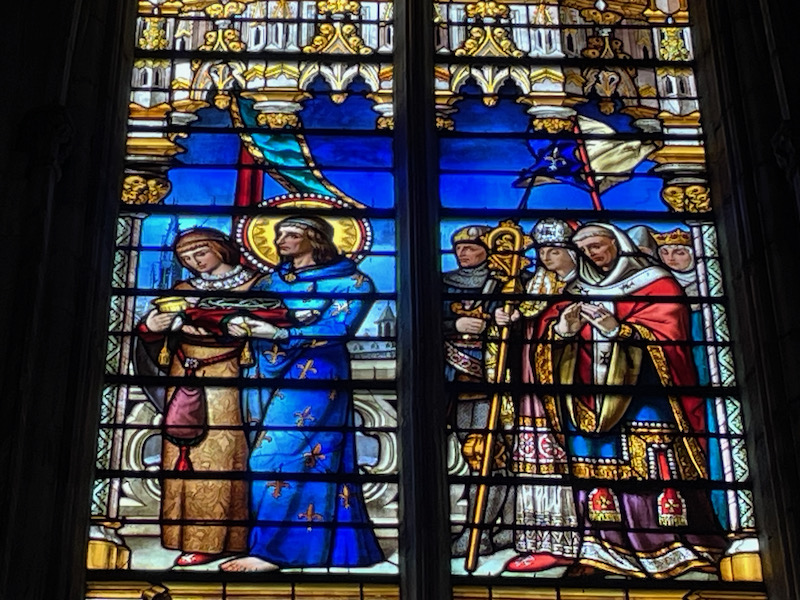
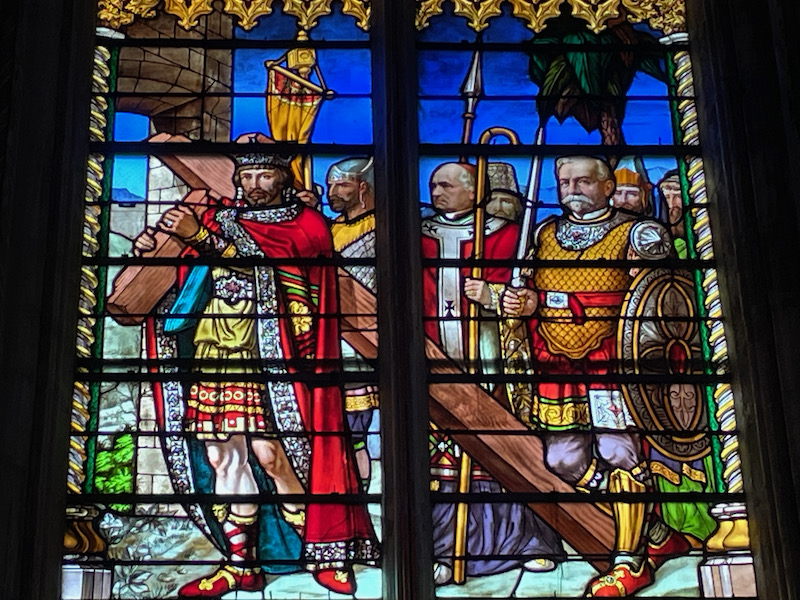
This window comes from the former convent of Saint-Pantaléon in Toulouse. The iconography represents the life of Saint Francis of Paola, an Italian friar who founded the Order of Minims. There is quite a bit of brown color here, because the Minims monks wore brown clothing. The window was created in 1877 by a local glass artist from Toulouse (you can see his name, P Chalons, along with the city of Toulouse and the date of 1877 in the lower-right corner).
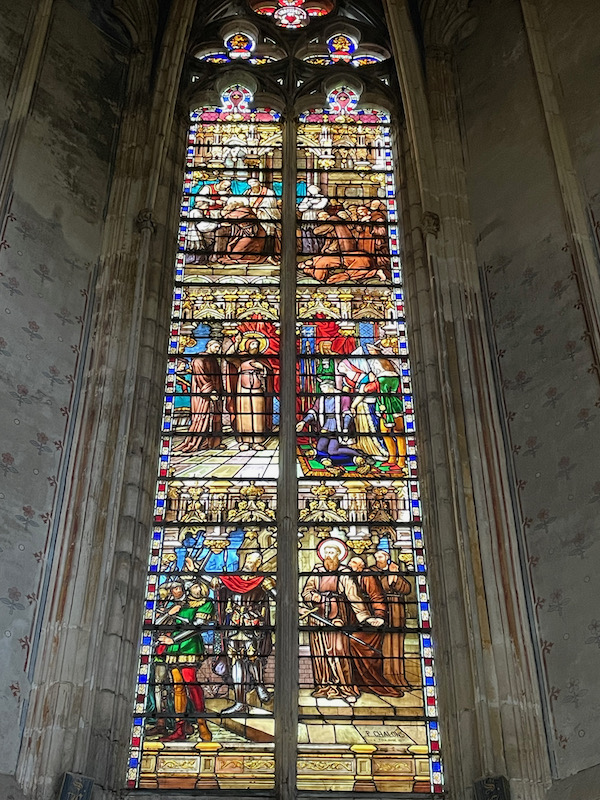
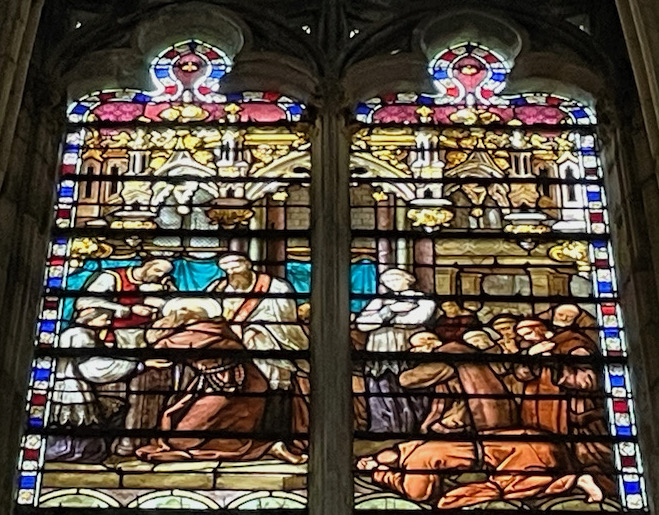
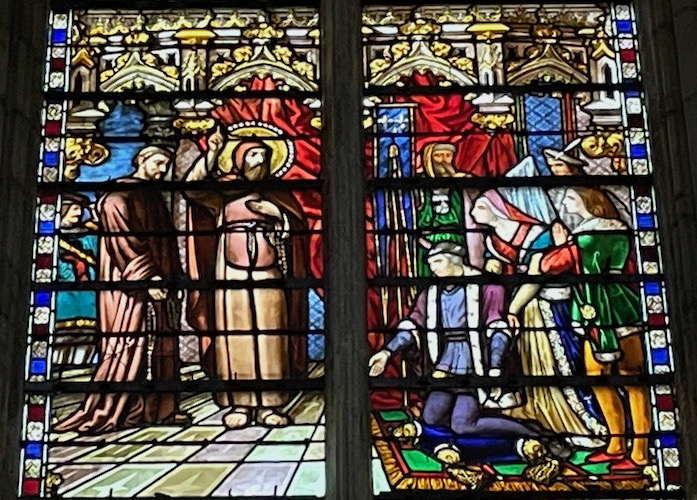
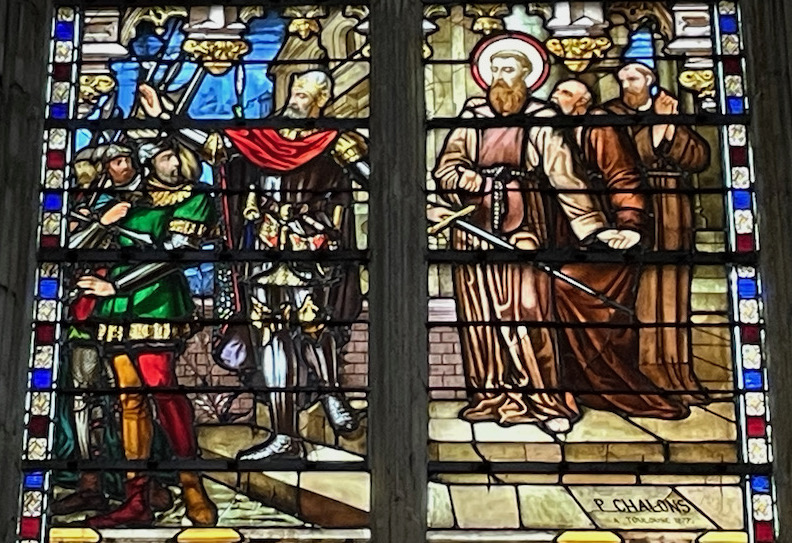
The window in the Chapel Saint-Augustin is thought to be the oldest stained-glass window in the Cathedral, dating back to around 1400. The upper register depicts the Annunciation, with the Archangel Gabriel kneeling on the left before the Virgin Mary, on the right, standing next to a vase of lilies. The in the middle register, there is a Bishop (wearing the mitre hat of a bishop) and Saint Catherine holding a palm of martyrdom. The lower register show the 2 donors in prayer: Archbishop Pierre de Saint Martialagenouillé (Archbishop of Toulouse from 1372-1401) on the left and his brother, Cardinal Hugues de Saint Martial on the right.
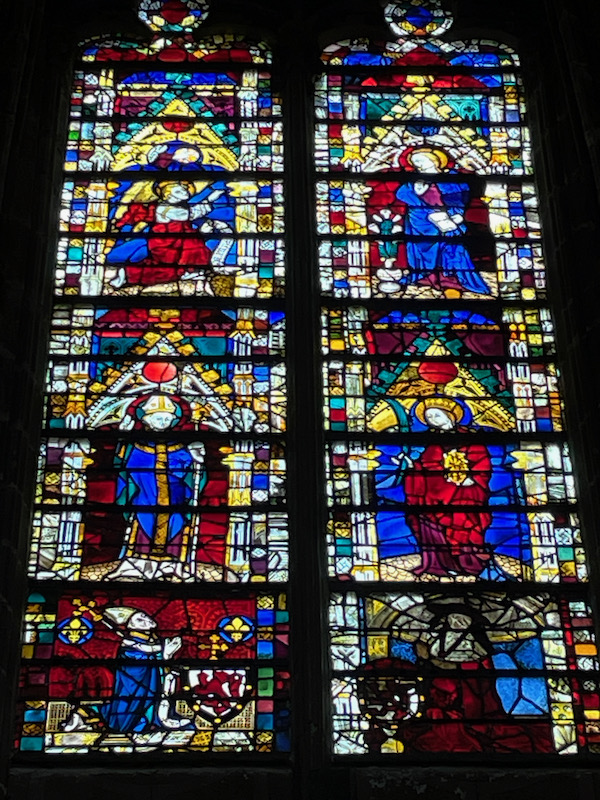
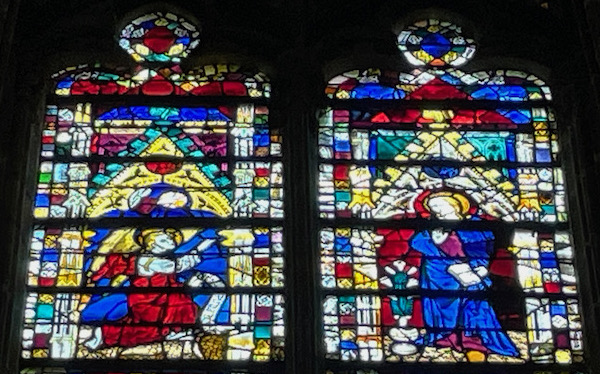
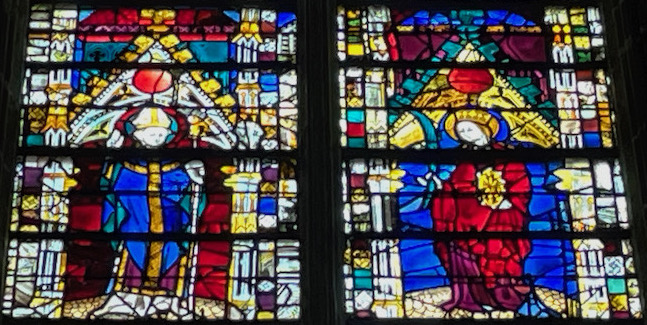

This window, in the Chapel of Saint Vincent de Paul is the "busiest" in the Cathedral, in my opinion. There is so much going on here that it is a bit difficult to take it all in. Dating back to the 14th century, the stained-glass comes from the Convent of the Jacobins but it was reassembled in the 19th century when it was moved from the Jacobins to the Cathedral. This may be why it seems so busy. In the detailed pictures, on the left we see Saint Michael weighing souls (top) and then Saint Michael slaying the dragon (bottom), and on the right, a priest exorcising a dying man (top) and the Virgin and child (bottom). The next set of panes going down are 2 angels carrying candles. The last (short) panes at the bottom have the faces (very small ones) of the donors.
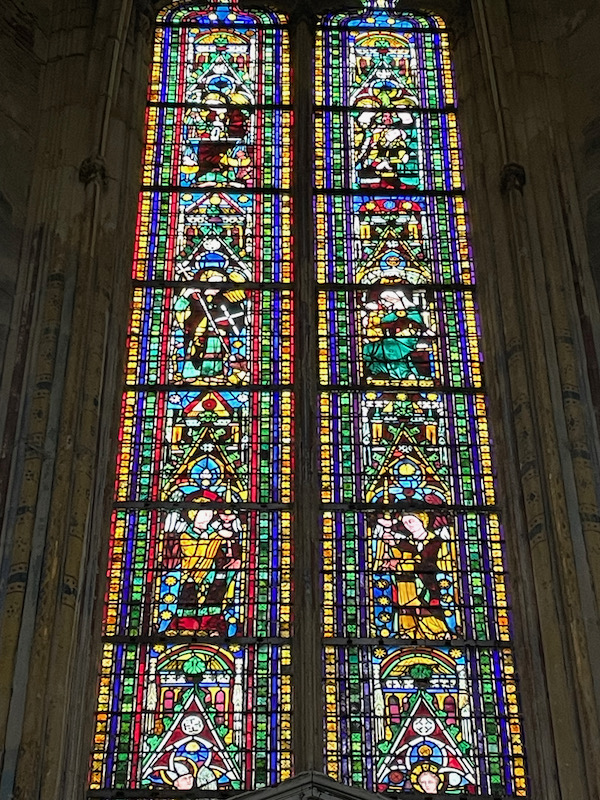
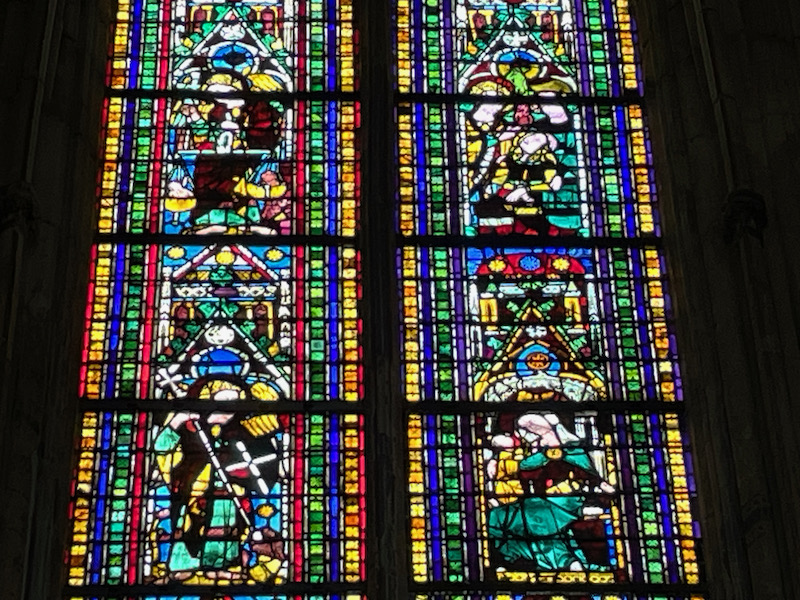
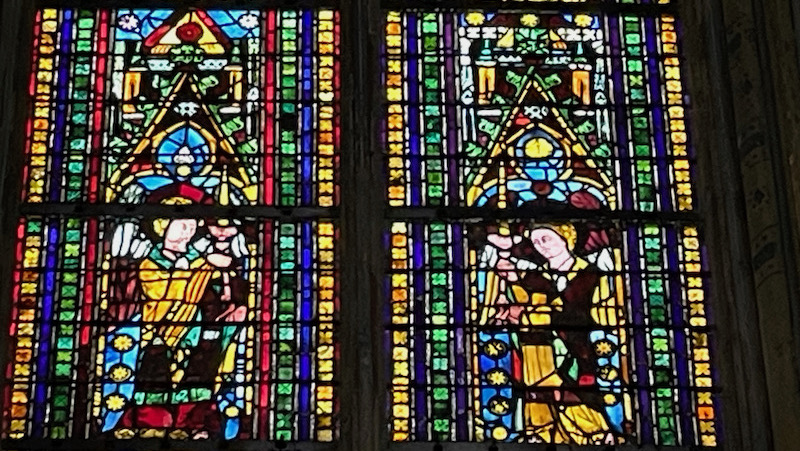
Chapel of Saint Jacques has a single window, which is narrow but tall, and the glass dates from the 16th century. It seems that the panes perhaps came from different windows from the Convent of the Jacobins and were put together in this window. At the top is the Virgin and Child under a canopy, and at the bottom is Saint Dominic holding a branch of lilies. The figure in the middle remains unknown.
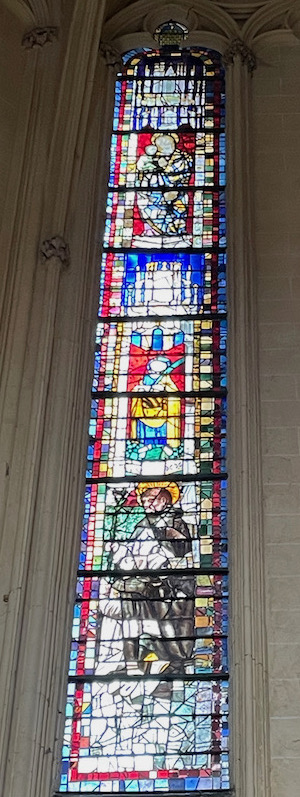

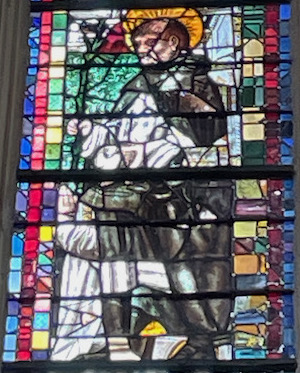
In the Chapel of Saint Peter, the window is a little odd compared to the others. In the middle section, we see Gothic characters representing Saint Celse (left) and Saint Nazaire (right), dating from the 14th century and coming from a stained-glass window of the Convent of the Jacobins in Toulouse. Then above and below them, we see a mesh of colored glass with clear glass. The glass itself comes from the 13th century (colored ones) and 15th century (clear ones). These 2 sections were created during a restoration in 2018. The glass artist decided to rearrange the window by moving the characters to the middle so that they were more readable.
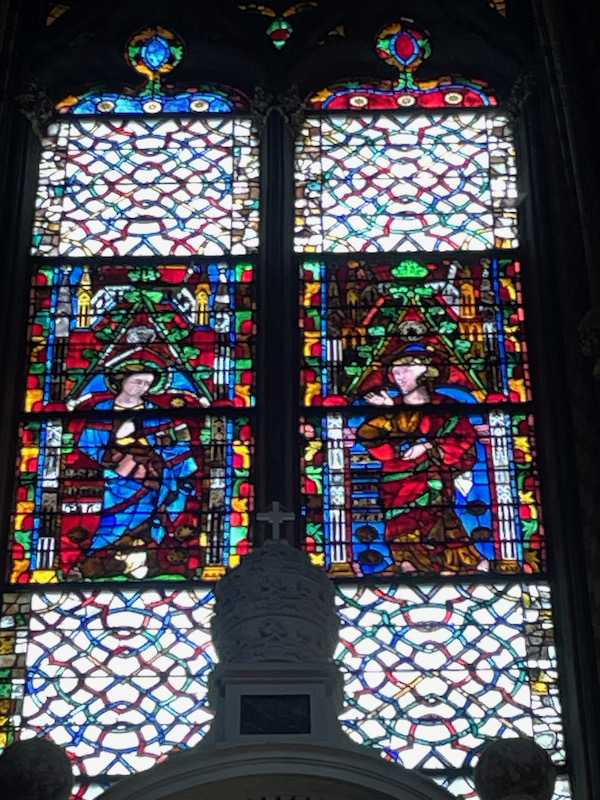
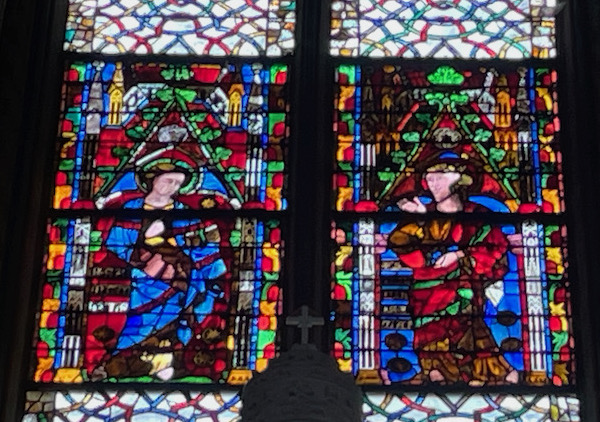
Our last window is that of the Chapel of Saint Roch. This window has probably the largest percentage of the "silver yellow" color/technique that I mentioned earlier. Here we see Bishops facing each other, one wearing blue and the other wearing red. For me, it looks like the bottom panes have been replaced and not very well, because the pictures seem not lined up from what looks like the top of a building and then what is below it.
